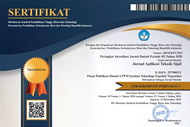Pengaruh Tata Guna Lahan Terhadap Hidrograf Aliran Di Sub-Sub DAS Keyang-Slahung-Tempuran Menggunakan Model SWAT
Abstract
Generally, area development leads land use changing that may cause surface runoff increases. These alterations are responsible for flood and inundation in certain areas. Soil and Water Assessment Tool (SWAT) can be used to perform rainfall-runoff model. Hence, the flow change can be estimated comprehensively. To ensure the reliability of the model, calibration and validation are required. The calibration and validation stages were conducted using SUFI-2 (Sequential Uncertainty Fitting Version 2) method to determine the most influential or sensitive parameter. Meanwhile, the reliability test was assessed using the , NSE, and PBIAS methods. The reliability test for the calibration and validation provides a good result. In advance, this research shows that the increase of forest area may decreases the peak flow during flood occurrence.
Keywords
Full Text:
PDFReferences
J. K. Thakur, K. Khanal, and P. Kabita, “Land cover changes for enhancing water availability in watersheds of Tanahun and Kaski, Nepal,” Journal of Water and Climate Change, 10(2), 431-448. 2019.
J. G. Arnold, R. Srinivasan, R. S. Muttiah, dan J. R. Williams, “Large-area hydrologic modeling and assessment: Part I. Model development,” J. American Water Resour. Assoc. 34(1): 73-89. 1998.
Tasdighi, Ali, Mazdak Arabi, and Daren Harmel, “A probabilistic appraisal of rainfall-runoff modeling approaches within SWAT in mixed land use watersheds,” Journal of hydrology : 476-489. 2018.
D. Ainunisa, G. Halik, W. Y. Widiarti, “Pemodelan Perubahan Tataguna Lahan Terhadap Debit Banjir DAS Tanggul, Jember Menggunakan Model SWAT (Soil and Water Assessment Tool),” Rekayasa Sipil 14.2 : 154-161. 2020.
M. G. A. S. Arceo, R. V. O. Cruz, C. L. Tiburan Jr, J. B. Balatibat, and N. R. Alibuyog, “ Modeling the hydrologic responses to land cover and climate changes of selected watersheds in the Philippines using soil and water assessment tool (SWAT) model,” DLSU Bus. Econ. Rev, 28, 84-101. 2018.
J. K. Kibii, E. C. Kipkorir, and J. R. Kosgei, “ Application of Soil and Water Assessment Tool (SWAT) to evaluate the impact of land use and climate variability on the Kaptagat catchment river discharge,” Sustainability, 13(4), 1802. 2021.
E. Junaidi and S. D. Tarigan, “Application SWAT Hydrology Model in Cisadane Watershed Management,” J. Penelit. Hutan dan Konserv. Alam, vol. 9, no. 3, pp. 221–237, 2012.
A. C. Cindy Harifa, M. Sholichin, and T. B. Prayogo, “Analisa Pengaruh Perubahan Penutupan Lahan Terhadap Debit Sungai Sub Das Metro Dengan Menggunakan Program Arcswat,” J. Teknik Pengair., vol. 008, no. 01, pp. 1–14, 2017.
M. K. R. Basthoni, “Basthoni, M. K. R. (2020). Analisis Perubahan Tata Guna Lahan Terhadap Debit Banjir Sub-Sub DAS Keyang-Slahung-Tempuran (KST),” TERAS JURNAL, 10(2), 189-202. 2020.
D. N. Moriasi, J. G. Arnold, M. W. Van Liew, R. L. Binger, R. D. Harmel, T. L. Veith, “Model evaluation guidelines for systematic quantification of accuracy in watershed simulations,” Transactions of the ASABE 50(1):885-900. 2007.
M. W. Van Liew, J. G. Arnold, J. D. Garbrecht, “Hydrologic simulation on agricultural watershed : Choosing between two models,” Transactions of the ASAE 46(6):1539-1551. 2003.
G. P. Fernandez, G. M. Chescheir, R. W. Skaggs, D. M. Amatya, “Development and testing of watershed-scale models for poorly drained soils,” Transactions of the ASAE 48(2):639-652. 2005.
DOI: http://dx.doi.org/10.12962%2Fj2579-891X.v21i1.14257
Refbacks
- There are currently no refbacks.

Jurnal Aplikasi Teknik Sipil by Pusat Publikasi Ilmiah LPPM Institut Teknologi Sepuluh Nopember is licensed under a Creative Commons Attribution-ShareAlike 4.0 International License
Based on work at https://iptek.its.ac.id/index.php/jats




